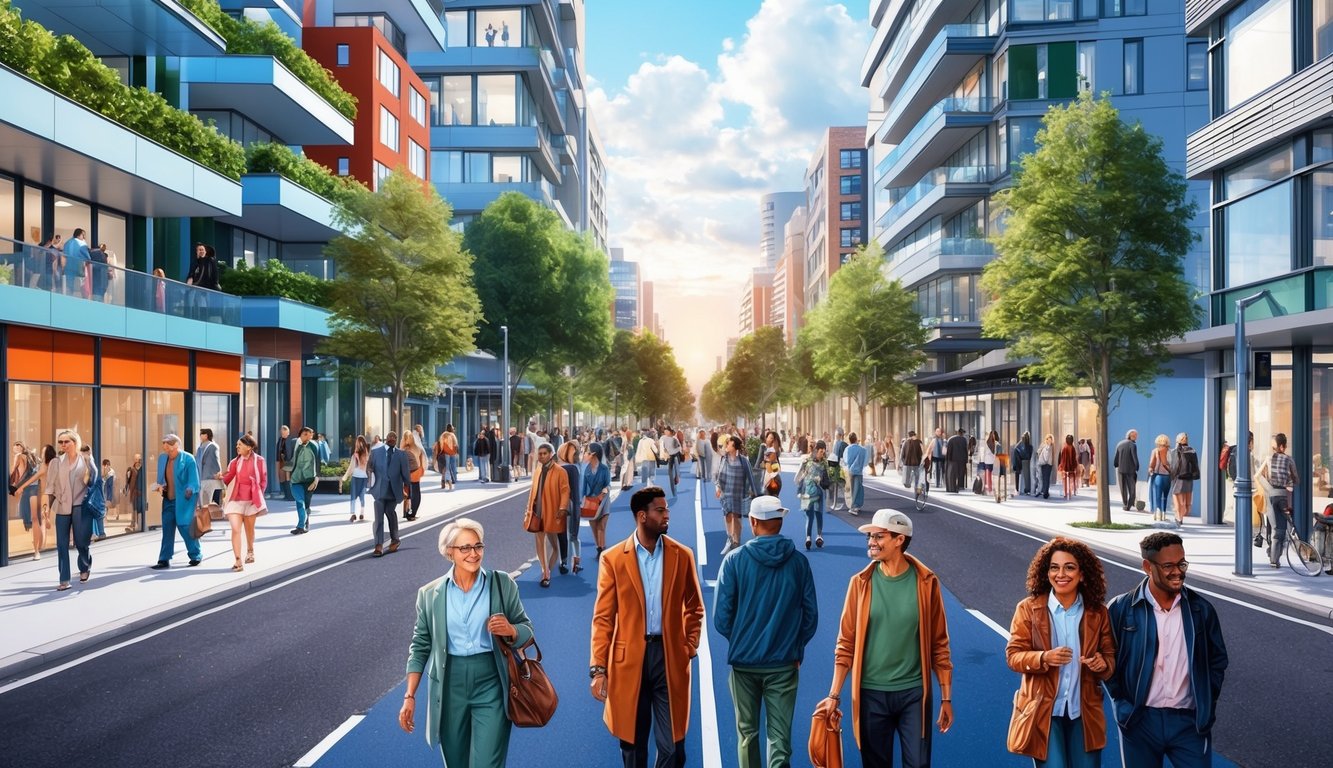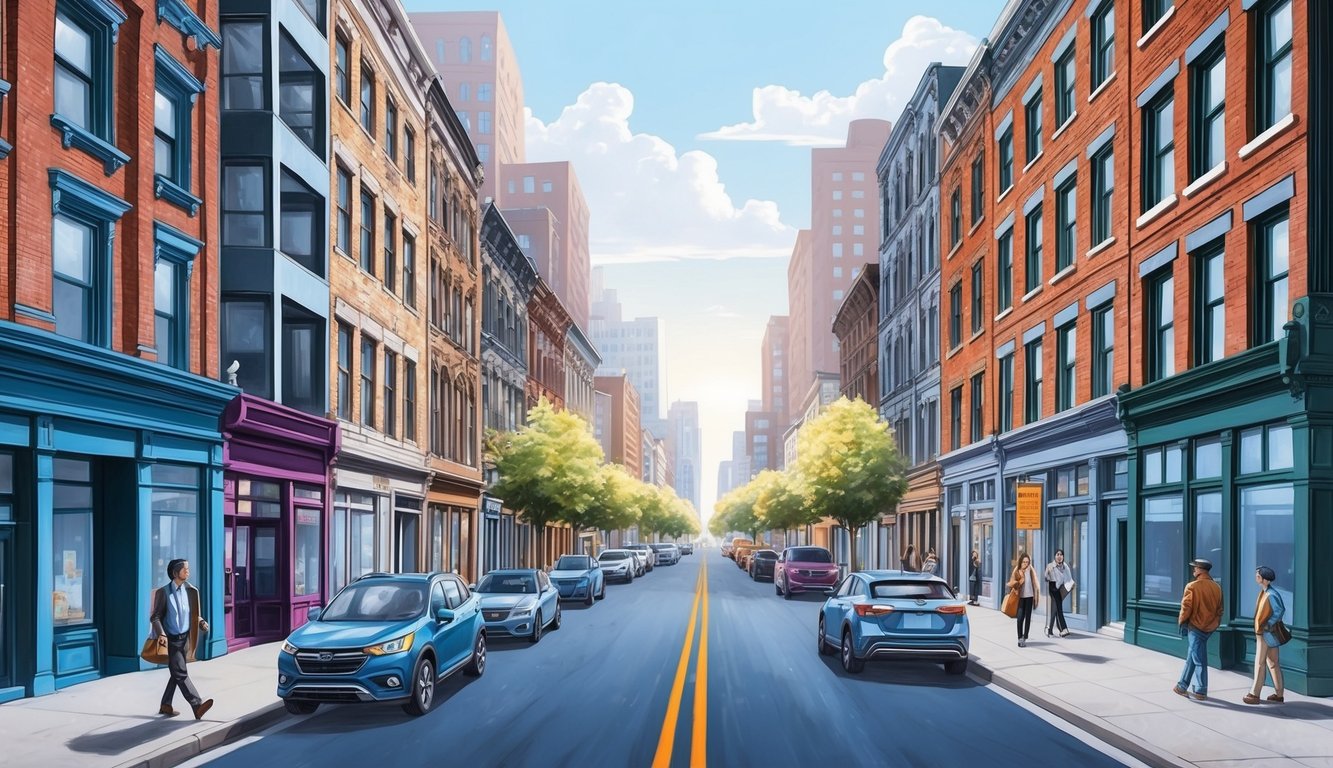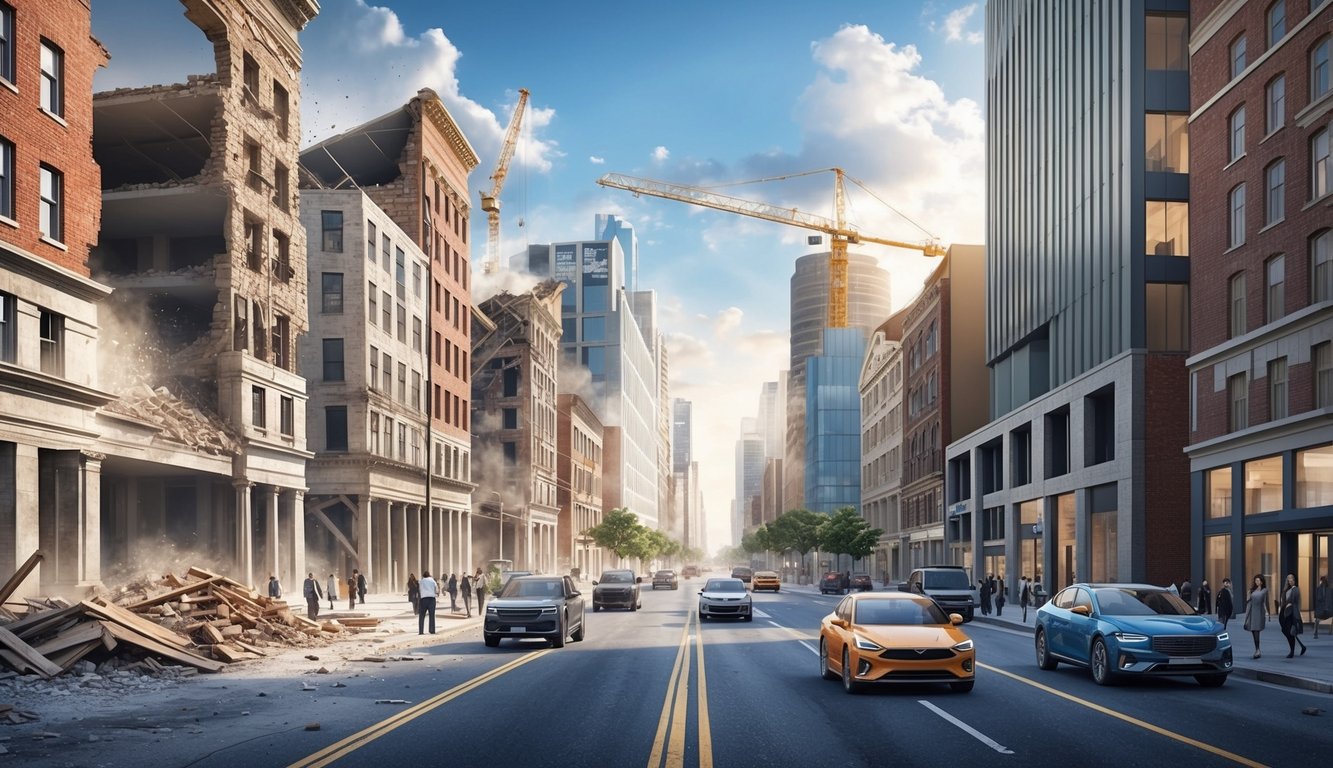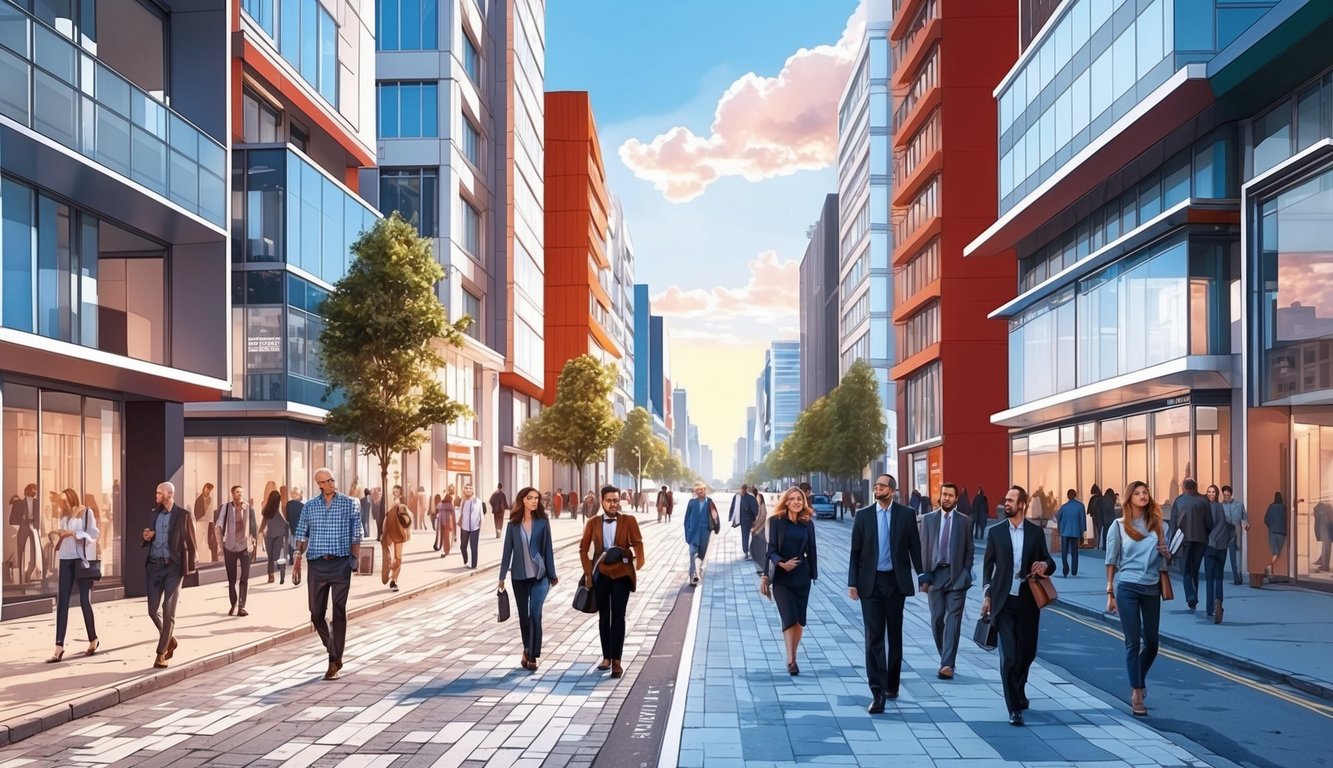Urban Renewal Overview
Urban renewal encompasses strategies aimed at revitalizing deteriorating urban areas.
These strategies focus on enhancing sustainability, improving living conditions, and stimulating economic growth.
This process often involves addressing challenges such as urban sprawl, gentrification, and urbanization, all while considering the needs of the urban population.
Concepts and Principles
Urban renewal involves several key concepts aimed at transforming urban spaces.
It encompasses redevelopment, rehabilitation, and preservation of historical structures.
Sustainability is a critical principle, promoting development that meets present needs without compromising future generations.
You should consider the potential impacts on community demographics due to urban renewal.
Revitalization can elevate property values and attract new residents, which may lead to gentrification.
Balancing revitalization with inclusiveness ensures that existing low-income populations are not unfairly displaced.
Key components include:
- Community Engagement: Involving local residents in planning.
- Environmental Considerations: Promoting green spaces and energy efficiency.
- Economic Development: Supporting local businesses.
Urban Renewal vs. Urban Regeneration
While urban renewal and urban regeneration are often used interchangeably, they have distinct focuses.
Urban renewal typically refers to physical redevelopment initiatives aimed at addressing blight and improving infrastructure.
It often results in significant alterations to the urban landscape.
Conversely, urban regeneration involves a broader spectrum of activities, including economic and social considerations.
This process seeks not only to enhance physical spaces but also to foster community ties and improve the quality of life for residents.
Key differences include:
- Focus: Renewal is infrastructure-centric; regeneration emphasizes community wellbeing.
- Scope: Renewal may lead to extensive changes; regeneration aims for holistic improvement.
- Community Impact: Regeneration prioritizes social equity alongside physical development.
Understanding these differences helps you navigate projects effectively, ensuring that the initiatives you support contribute positively to urban sustainability and community wellness.
Global Case Studies

This section explores significant urban renewal initiatives from around the globe, focusing on Seoul, Ahmedabad, and Barcelona.
Each case highlights different approaches to sustainable urban renewal, emphasizing community participation and the preservation of cultural heritage.
Case Study: Seoul
Seoul’s urban renewal efforts have transformed neglected spaces into vibrant public areas.
The Cheonggyecheon Restoration Project is a prime example.
This initiative involved removing an elevated highway to uncover a buried stream, revitalizing the surrounding area.
Key features of this project include:
- Community Engagement: Residents were involved in planning and decision-making.
- Cultural Heritage: The project preserved historical landmarks along the stream.
- Sustainable Practices: Emphasis on green spaces improved the urban ecosystem.
These elements contribute to a thriving urban environment and increased property values, illustrating the potential benefits of insurance in urban improvements.
Case Study: Ahmedabad
Ahmedabad’s Riverfront Development Project serves as a model for sustainable urban renewal in India.
The initiative aimed to revitalize the Sabarmati River, enhancing public spaces while promoting economic development.
This project encompasses:
- Community Spaces: Creation of parks and walking paths along the river.
- Cultural Integration: Preservation of local heritage sites, fostering community pride.
- Environmental Consideration: Strategies to improve water quality and reduce flooding.
The project highlights the role of insurance in safeguarding investments, ensuring that urban enhancements withstand environmental challenges.
Case Study: Barcelona
Barcelona’s approach to urban renewal emphasizes public spaces and cultural identity.
Notable projects include the Superblocks initiative, which transforms city streets into pedestrian-friendly areas.
Key aspects of this initiative involve:
- Public Participation: Local residents actively contribute to design and implementation.
- Cultural Heritage Preservation: Restoration of historical sites amid urban development.
- Sustainable Urban Mobility: Enhanced infrastructure for biking and walking reduces traffic congestion.
Such initiatives demonstrate how strategic urban planning can elevate community life and serve as a basis for insurance strategies that protect urban investments.
Social and Economic Impacts

Urban renewal initiatives can significantly influence both the social fabric and economic prosperity of a community.
This section explores how these projects impact the quality of life for residents, while also addressing challenges such as gentrification and displacement.
Quality of Life and Standard of Living
Improving the quality of life in urban renewal projects often involves enhancing public infrastructure, such as parks, schools, and transportation.
These developments can lead to increased property values and an overall higher standard of living for residents.
Key benefits may include:
- Enhanced Community Services: Access to better healthcare, education, and recreational facilities.
- Increased Safety: Upgrades in infrastructure often lead to decreased crime rates through community engagement and improved lighting.
- Social Interaction: With better public spaces, residents experience more opportunities for social interaction and community participation.
These factors collectively contribute to a more vibrant atmosphere, fostering greater community cohesion and well-being.
Gentrification and Displacement
While urban renewal can elevate living standards, it can also lead to negative consequences, such as gentrification.
This process often results in the displacement of lower-income residents, particularly the urban poor, who may no longer afford to live in gentrified neighborhoods.
Challenges associated with gentrification include:
- Rising Housing Costs: Property development typically drives up rents, pushing out long-time residents.
- Loss of Community Identity: As new, wealthier residents move in, long-standing cultural and social networks may dissolve.
- Limited Access to Resources: Displaced families often face difficulties finding affordable housing and maintaining their quality of life.
Addressing these complex issues requires careful planning and community involvement to mitigate adverse effects while maximizing potential benefits.
Planning and Design Strategies

Effective planning and design strategies are essential for successful urban renewal projects.
These strategies focus on ensuring that urban spaces are functional, sustainable, and inclusive while promoting public participation and enhancing community engagement.
The Role of Urban Planners
Urban planners play a crucial role in shaping the vision for urban renewal.
They analyze demographics, land use, and environmental factors to guide the development process effectively.
By conducting comprehensive assessments, you ensure that projects align with community needs.
Public participation is vital in this phase.
Engaging residents in the planning process fosters a sense of ownership and ensures that their voices are heard.
It also helps to mitigate conflicts that could arise during implementation.
Collaboration with architects and designers is integral.
Together, you can create plans that embrace innovative design principles while adhering to regulatory frameworks.
This collaboration results in well-designed public spaces that enhance the community’s quality of life.
Adaptive Reuse of Industrial Areas
The adaptive reuse of industrial areas has gained traction as a sustainable design strategy.
This approach reimagines existing structures for new purposes, minimizing waste and preserving historical value.
By repurposing old factories or warehouses, you can transform these spaces into residential, commercial, or mixed-use developments.
This not only maintains architectural heritage but also meets the growing demand for urban living.
Engaging with the community during this process ensures that redevelopment initiatives meet local needs and expectations.
It can enhance public spaces and provide amenities that benefit the community.
Utilizing adaptive reuse strategies is cost-effective, often requiring less investment than new construction.
Additionally, these projects can have positive implications for the insurance industry by lowering risks associated with new builds, as they capitalize on existing infrastructure.
Challenges in Urban Renewal

Urban renewal projects often face significant obstacles that can hinder progress and sustainability.
Addressing these challenges is crucial for achieving successful outcomes in urban redevelopment, especially in inner cities.
Dealing with Informal Settlements
You may encounter informal settlements in urban renewal efforts, which pose unique challenges.
These areas often lack proper infrastructure, housing rights, and essential services.
Strategies to address these challenges include:
- Regularization: Implementing policies that recognize informal settlements can lead to better planning and resource allocation.
- Infrastructure improvements: Upgrading infrastructure within these areas improves living conditions and fosters community cohesion.
- Public engagement: Involving residents in these settlements ensures their needs and voices are considered in decision-making.
Failure to manage informal settlements can lead to increased social tensions and resistances to urban renewal initiatives.
Engaging Stakeholders and the Community
Engaging stakeholders effectively is critical for successful urban renewal.
You must identify all relevant parties, including government agencies, private investors, and community organizations.
Key approaches include:
- Public participation: Facilitate open forums where community members can voice their concerns and ideas.
- Transparent communication: Keep stakeholders informed about project goals, timelines, and impacts.
- Collaborative partnerships: Work with local organizations to foster trust and promote investment in urban renewal initiatives.
By prioritizing engagement and participation, you create a sense of ownership among community members.
This approach is vital for ensuring long-term sustainability in urban redevelopment efforts.
Frequently Asked Questions

Urban renewal projects often raise important considerations regarding demographic changes, economic impacts, environmental issues, and the challenges faced during implementation.
Understanding these aspects can provide valuable insights into how these initiatives affect both communities and the broader urban landscape.
How have urban renewal projects impacted city demographics?
Urban renewal projects can lead to significant demographic shifts in cities.
You may observe changes in population density, socioeconomic status, and the diversity of residents.
Gentrification is a common result, where wealthier individuals move into previously marginalized neighborhoods, often driving up housing costs and displacing long-time residents.
In what ways have urban renewal initiatives driven economic development?
Urban renewal initiatives can stimulate local economies by attracting new businesses and investment.
You might see the revitalization of commercial areas, creating job opportunities and enhancing property values.
Projects focused on infrastructure improvements can further bolster economic activity, making neighborhoods more appealing to both residents and businesses.
What are the environmental considerations in urban renewal case studies?
Environmental considerations play a crucial role in urban renewal.
You should think about how projects address sustainability, resource management, and the ecological impact of redevelopment.
Strategies might include incorporating green spaces, enhancing public transportation, and implementing energy-efficient building practices.
What are common challenges faced during urban regeneration efforts?
Challenges in urban regeneration often arise from funding constraints, community opposition, and regulatory hurdles.
You may encounter difficulties in balancing development goals with residents’ needs and historical preservation.
Engaging the community early in the planning process can alleviate some of these issues.
How do urban renewal strategies vary between different countries?
Urban renewal strategies can differ significantly based on cultural, economic, and governmental factors.
You might find that countries with stronger regulatory frameworks focus on sustainable development, while others prioritize rapid urbanization.
Each approach shapes the outcomes and effectiveness of renewal initiatives.
What role do public-private partnerships play in urban renewal projects?
Public-private partnerships (PPPs) are vital in facilitating urban renewal.
These collaborations leverage resources and expertise from both sectors, promoting innovative solutions.
Successful PPPs often lead to enhanced project funding, shared risks, and improved service delivery in urban regeneration efforts.






